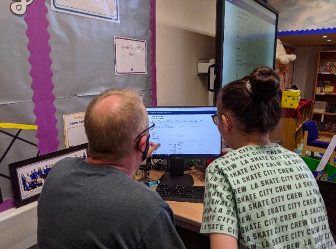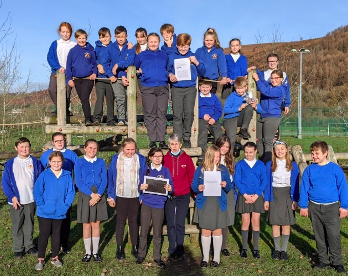2021 December 17
Christmas comes early for Comet Chasers
An important role of the BAA is public outreach whereby we aim to engage members of the public to take an interest in things astronomical, and even to get involved in actual observations of celestial objects. We also aim to educate. One recent example that combines both of these aspirations is an innovative science education project called ‘Comet Chasers’ which links schools with professional comet scientists, BAA members and other amateur observers around the world, using state-of-the-art robotic telescopes to help unlock the mysteries of asteroids and comets.
Children from four Welsh primary schools are helping astronomers study a strange solar system object. The schools are now very excited to see their observations featured in a research paper recently published in the prestigious Astrophysical Journal.

BAA members Tony Angel, Richard Miles and Helen Usher have been helping the 7-11 year old children to observe and measure the asteroid 2005 QN173. This has developed an unusual long tail, a very rare behaviour normally only associated with icy comets. The specific observation parameters were agreed with Dr Henry Hsieh from the Planetary Science Institute in the USA, who is leading an international study of this strange object.
Children from St Mary’s Catholic Primary School in Bridgend, Ynysowen Community School, and Mount Street School in Brecon made research observations using the 2-metre Faulkes Telescope North in Hawaii. And Montgomery Church in Wales School in Powys is helping with the ongoing observations.
The newly published research reveals more details of this intriguing object, now re-classified as a Main Belt Comet (Comet 433P) as it shares characteristics of both a Main Belt asteroid and an icy comet. Discovered in 2005, it appeared to be a typical asteroid in the Main Belt of asteroids between Mars and Jupiter – looking like a moving, star-like point of light. But this year its appearance was completely different, as it developed a thin straight tail. Such objects are rare – only 20 have been observed so far.
They are interesting, because a substantial part of Earth’s water is thought to have been delivered via asteroid impacts when the Earth was being formed. The activity being observed for these objects means they are likely to still contain ice. They therefore offer a way to test this hypothesis and to learn more about the origins of life on Earth. We are learning more about the abundance, distribution, and physical properties of icy objects in the inner Solar System.
The research suggests that the nucleus of 433P is about 3.2 km across and is surrounded by a dust cloud. In the children’s observations, the tail was measured as over 720,000km long, but just 1,400km wide. The narrow tail tells scientists that the dust is barely floating off the nucleus at very slow speeds. The flow of gas (which usually is the cause of dust escaping a comet) is very weak, which raises questions for future study: ‘What is causing the dust to escape?’ ‘Is it a fast-rotating object flinging off material from its surface?’. The Welsh Comet Chasers are continuing to make observations, and so they will be helping to try to solve these mysteries too.
The lead author of the paper, Dr. Henry Hsieh, is very grateful for the data provided by the young Welsh astronomers: “The Faulkes Telescope observations collected by the Comet Chasers students really helped our study thanks to some of the unique capabilities of the telescope, and the speed of response to requests for observations”, he said. “We’re very happy to have these students and their teachers and mentors be able to make real contributions to this research and are looking forward to continuing working with Comet Chasers students in the coming year.“

“Comet Chasers is exactly the sort of thing the Faulkes Telescope Project was set up to do – school children can directly control a multi-million-pound telescope, and, with the guidance of keen amateur and professional astronomers, they can really help contribute to astronomical research – and have great fun at the same time!” said Professor Paul Roche, an astronomer at Cardiff University.
The children in Ynysowen said they loved every minute of the Comet Chasers project. “Having total control of a big telescope was so much fun”.
Open University PhD student Helen Usher, who is working on data from the Rosetta Mission to Comet 67P, has been leading the Comet Chasers project in her home area of Wales.
Helen Usher said, “ I am really enjoying leading the Comet Chasers project, working with the Faulkes Telescope Project. It is great to see children (and their teaching staff!) getting enthused and excited learning about space, and especially comets and asteroids. As well as learning about what we know, they are making their own scientific observations using the remote telescopes to help explore what we don’t yet know. If you had told me when I was a pupil in a small school in the South Wales valleys that I could work on a space mission and make scientifically important observations I would never have believed you! So I’m particularly keen to show current school children how they can do this too.”

Tony Angel, an amateur astronomer now based in Spain, commented: “I have always enjoyed being involved in Pro-Am projects like this. Comet Chasers is about passing our knowledge on and bringing the wonders of astronomy to children. I think this is a very important role for us as RAS Fellows and BAA members. Hopefully it will lead to some of these children becoming astronomers!”.
There is more excitement to come too. The Comet Chasers schools are observing other comets for different research projects, including the Mission 29P observing campaign of the British Astronomical Association (BAA) led by Dr Richard Miles. A few weeks ago, the Hubble Space Telescope (HST) performed a series of observations of the unique comet 29P/Schwassmann-Wachmann and, in support of HST following a request, schools have been able to obtain ‘ground-based’ images of this highly unusual object via the Las Cumbres Observatory. Dr Miles says, “Although amateurs can observe comets with their own small telescopes, for a distant object like 29P, access to larger telescopes located under favourable skies at locations around the world is vital to provide high-quality data we can link to the HST findings. These contributions from schools will add significantly to the body of scientific knowledge.” Further research papers are envisaged, including two already being drafted using Comet Chasers observations.
The schools also stand ready to respond quickly to requests for observations for new objects or where unusual activity is noted. Their quick access to the large telescopes of the Las Cumbres Observatory network of telescopes, through the Faulkes Telescope Project, really aids professional researchers who usually have to plan observations months in advance. The collaborations are certainly proving fruitful for everyone.
The project is about much more than just the scientific output though. The Comet Chasers team has been providing educational resources and hands-on support to teaching staff, allowing them to use the ‘Wow’ factor of space to engage and inspire learning across the curriculum. The enthusiasm of the teaching staff in each school, along with the support of BAA members, is key to the project’s success so far.
The team would be very happy for other schools to join the Comet Chasers project too! Contact Helen Usher, helen.usher@open.ac.uk
Teaser image: Pupils from Mount St Junior School Brecon showing some of the things they have learnt about through Comet Chasers. Photo courtesy Mount St Junior School, Brecon.
Notes for editors:
The four schools have been supported through the ‘Comet Chasers’ project, funded by the Science and Technology Facilities Council (STFC) via Techniquest. The project includes astronomers from the Open University and Cardiff University, working with the Faulkes Telescope Project, and assisted by Tony Angel, Richard Miles and Ben Wooding, from the amateur astronomy community (who are all co-authors of the paper). The Comet Chasers team has been providing educational resources and hands-on support to teachers to allow them to use the ‘Wow’ factor of space to engage, enthuse, and inspire learning across the curriculum.
Press release from the Planetary Science Institute with more science background https://www.psi.edu/news/asteroidandcomet
Press officer at PSI is Alan Fischer fischer@psi.edu
Astrophysical Journal Letters – https://iopscience.iop.org/article/10.3847/2041-8213/ac2c62 open access pre-print version at https://arxiv.org/abs/2109.14822?context=astro-ph
Contact Point:
Helen Usher, Open University/Faulkes Telescope Project helen.usher@open.ac.uk
| The British Astronomical Association supports amateur astronomers around the UK and the rest of the world. Find out more about the BAA or join us. |
